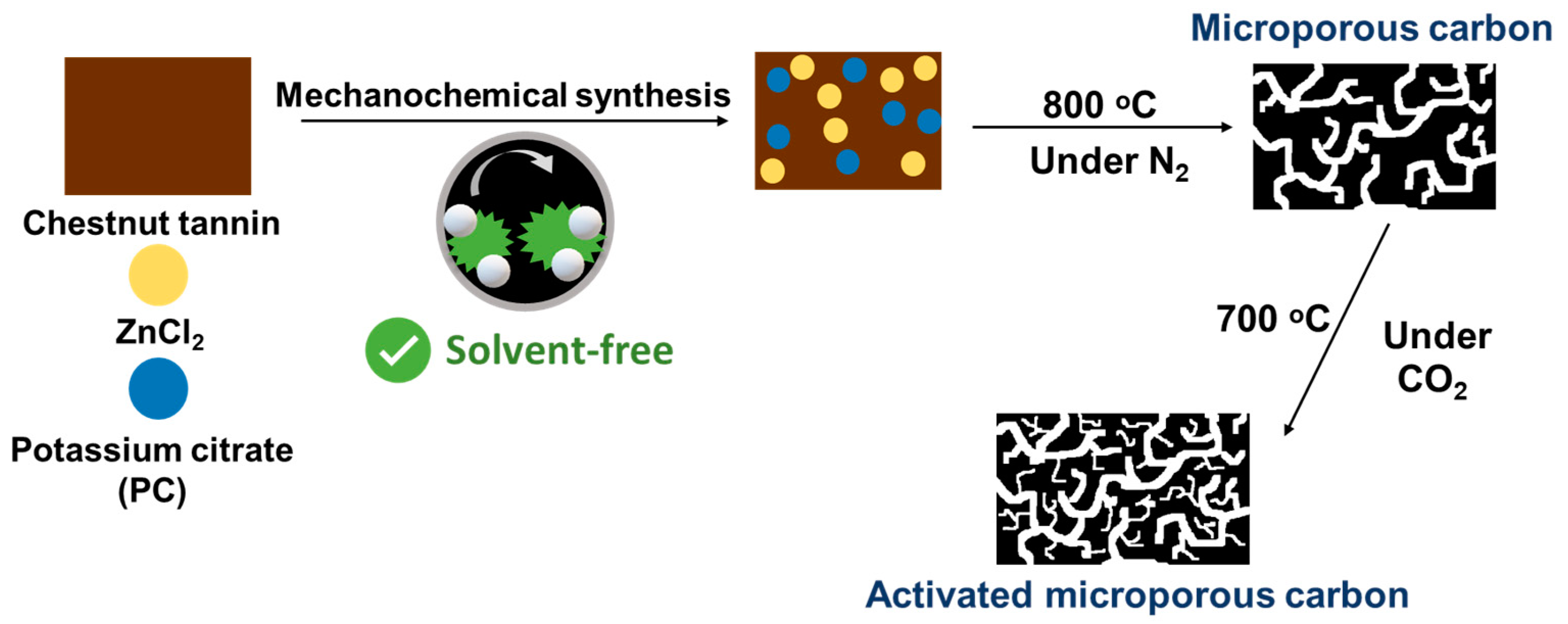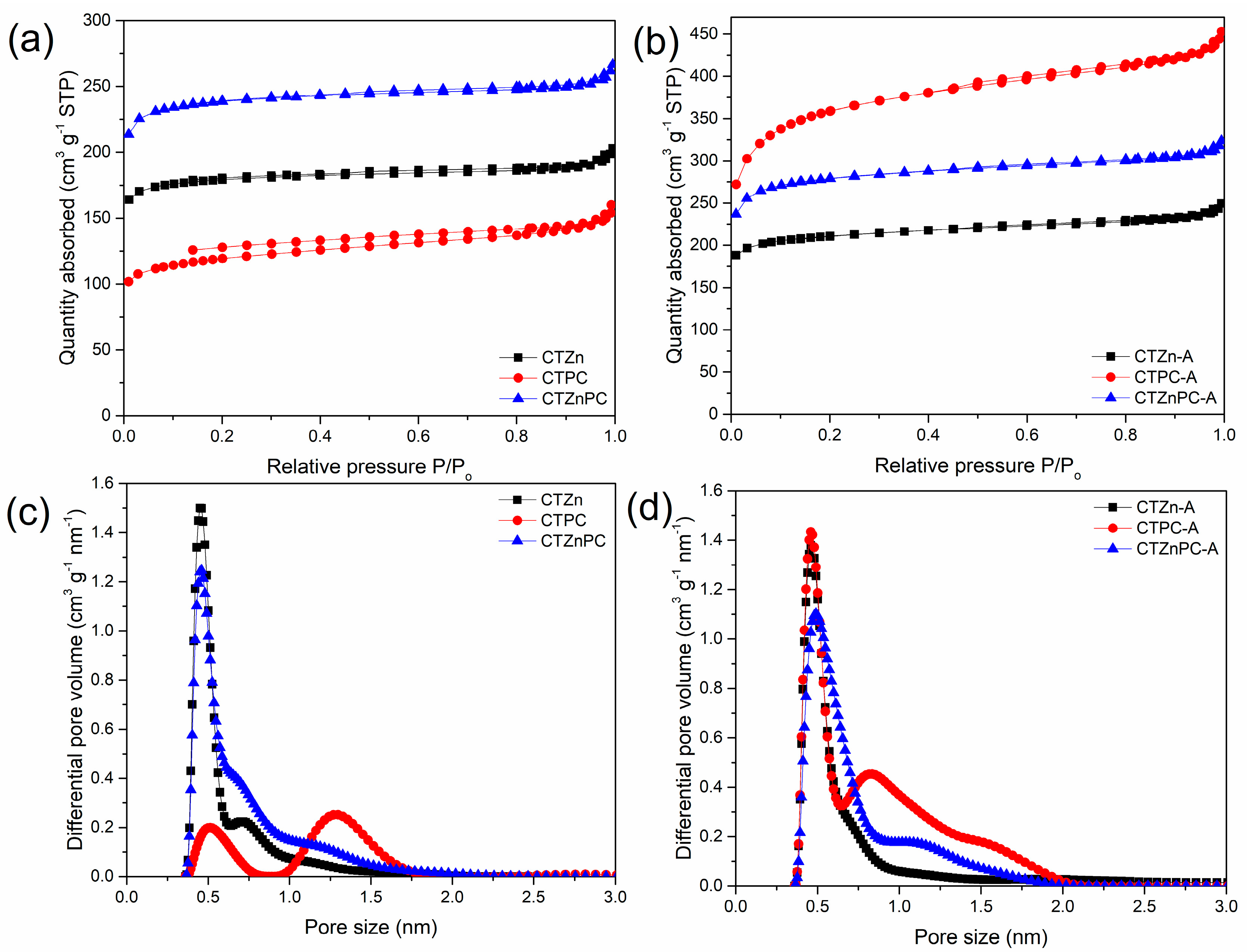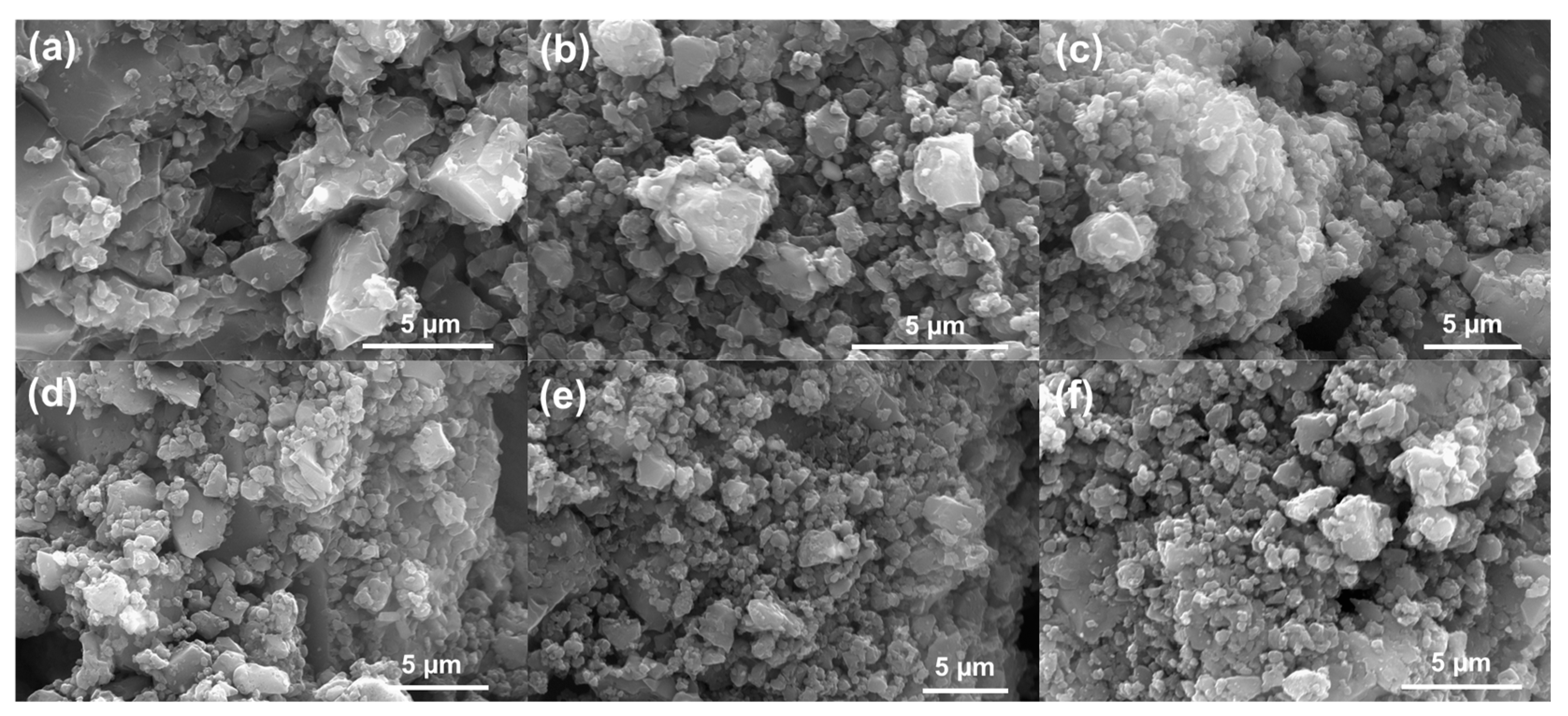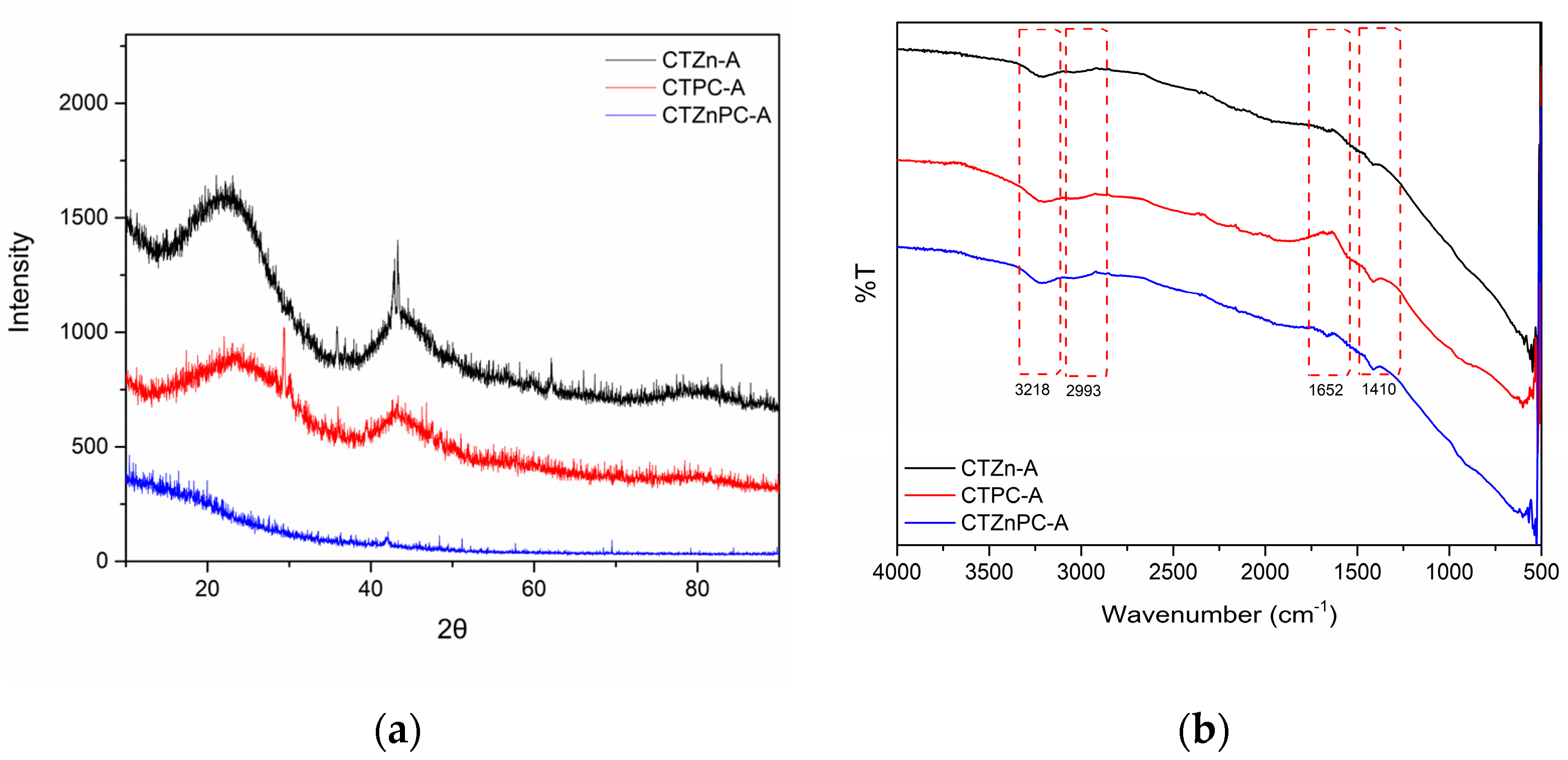Microporous Carbons Obtained via Solvent-Free Mechanochemical Processing, Carbonization and Activation with Potassium Citrate and Zinc Chloride for CO2 Adsorption
Abstract
1. Introduction
2. Materials and Methods
2.1. Chemicals and Reagents
2.2. Materials Synthesis
2.3. Characterization
3. Results and Discussions
CO2 Capture
4. Conclusions
Author Contributions
Funding
Data Availability Statement
Acknowledgments
Conflicts of Interest
References
- Gunawardene, O.H.P.; Gunathilake, C.A.; Vikrant, K.; Amaraweera, S.M. Carbon Dioxide Capture through Physical and Chemical Adsorption Using Porous Carbon Materials: A Review. Atmosphere 2022, 13, 397. [Google Scholar] [CrossRef]
- Jiang, Y.; He, Z.; Cui, X.; Liu, Z.; Wan, J.; Liu, Y.; Ma, F. Hierarchical Porous Carbon Derived from Coal Tar Pitch by One Step Carbonization and Activation Combined with a CaO Template for Supercapacitors. New J. Chem. 2022, 46, 6078–6090. [Google Scholar] [CrossRef]
- Chen, L.; Yuan, Y.; Zhang, D.; Lin, Z.; Lin, J.; Li, S.; Guo, S. Construction of 3D Hierarchical Honeycomb Macro/Meso/Micro-Porous Carbon with Soft and Hard Templates for High-Performance Sodium-Ion Batteries. Mater. Lett. 2023, 334, 133737. [Google Scholar] [CrossRef]
- Duraisamy, V.; Venkateshwaran, S.; Thangamuthu, R.; Senthil Kumar, S.M. Hard Template Derived N, S Dual Heteroatom Doped Ordered Mesoporous Carbon as an Efficient Electrocatalyst for Oxygen Reduction Reaction. Int. J. Hydrogen Energy 2022, 47, 40327–40339. [Google Scholar] [CrossRef]
- Phuriragpitikhon, J.; Ghimire, P.; Jaroniec, M. Tannin-Derived Micro-Mesoporous Carbons Prepared by One-Step Activation with Potassium Oxalate and CO2. J. Colloid Interface Sci. 2019, 558, 55–67. [Google Scholar] [CrossRef]
- Feng, Y.Y.; Chen, Y.Q.; Wang, Z.; Wei, J. Synthesis of Mesoporous Carbon Materials from Renewable Plant Polyphenols for Environmental and Energy Applications. Xinxing Tan Cailiao/New Carbon Mater. 2022, 37, 196–222. [Google Scholar] [CrossRef]
- De Souza, L.K.C.; Wickramaratne, N.P.; Ello, A.S.; Costa, M.J.F.; Da Costa, C.E.F.; Jaroniec, M. Enhancement of CO2 Adsorption on Phenolic Resin-Based Mesoporous Carbons by KOH Activation. Carbon 2013, 65, 334–340. [Google Scholar] [CrossRef]
- Yu, Q.; Bai, J.; Huang, J.; Demir, M.; Farghaly, A.A.; Aghamohammadi, P.; Hu, X.; Wang, L. One-Pot Synthesis of Melamine Formaldehyde Resin-Derived N-Doped Porous Carbon for CO2 Capture Application. Molecules 2023, 28, 1772. [Google Scholar] [CrossRef]
- Wickramaratne, N.P.; Jaroniec, M. Importance of Small Micropores in CO2 Capture by Phenolic Resin-Based Activated Carbon Spheres. J. Mater. Chem. A 2013, 1, 112–116. [Google Scholar] [CrossRef]
- Głowniak, S.; Szczęśniak, B.; Choma, J.; Jaroniec, M. Highly Porous Carbons Synthesized from Tannic Acid via a Combined Mechanochemical Salt-Templating and Mild Activation Strategy. Molecules 2021, 26, 1826. [Google Scholar] [CrossRef]
- Szczesniak, B.; Borysiuk, S.; Choma, J.; Jaroniec, M. Mechanochemical Synthesis of Highly Porous Materials. Mater. Horiz. 2020, 7, 1457–1473. [Google Scholar] [CrossRef]
- Zhao, L.Y.; Dong, X.L.; Lu, A.H. Mechanochemical Synthesis of Porous Carbons and Their Applications in Catalysis. Chempluschem 2020, 85, 866–875. [Google Scholar] [CrossRef]
- Krusenbaum, A.; Grätz, S.; Tigineh, G.T.; Borchardt, L.; Kim, J.G. The Mechanochemical Synthesis of Polymers. Chem. Soc. Rev. 2022, 51, 2873–2905. [Google Scholar] [CrossRef]
- Schneidermann, C.; Kensy, C.; Otto, P.; Oswald, S.; Giebeler, L.; Leistenschneider, D.; Grätz, S.; Dörfler, S.; Kaskel, S.; Borchardt, L. Nitrogen-Doped Biomass-Derived Carbon Formed by Mechanochemical Synthesis for Lithium–Sulfur Batteries. ChemSusChem 2019, 12, 310–319. [Google Scholar] [CrossRef]
- Dubadi, R.; Weidner, E.; Samojeden, B.; Jesionowski, T.; Ciesielczyk, F.; Huang, S.; Jaroniec, M. Exploring the Multifunctionality of Mechanochemically Synthesized γ-Alumina with Incorporated Selected Metal Oxide Species. Molecules 2023, 28, 2002. [Google Scholar] [CrossRef]
- Dubadi, R.; Huang, S.D.; Jaroniec, M. Mechanochemical Synthesis of Nanoparticles for Potential Antimicrobial Applications. Materials 2023, 16, 1460. [Google Scholar] [CrossRef]
- Yuan, R.; Dong, Y.; Hou, R.; Shang, L.; Zhang, J.; Zhang, S.; Chen, X.; Song, H. Structural Transformation of Porous and Disordered Carbon during Ball-Milling. Chem. Eng. J. 2023, 454, 140418. [Google Scholar] [CrossRef]
- Mohamed, M.A.A.; Saadallah, H.A.A.; Gonzalez-Martinez, I.G.; Hantusch, M.; Valldor, M.; Büchner, B.; Hampel, S.; Gräßler, N. Mechanochemical Synthesis of Li-Rich (Li2Fe)SO Cathode for Li-Ion Batteries. Green Chem. 2023. [Google Scholar] [CrossRef]
- Wang, L.; Zhao, J.; Zhang, P.; Yang, S.; Zhan, W.; Dai, S. Mechanochemical Synthesis of Ruthenium Cluster@Ordered Mesoporous Carbon Catalysts by Synergetic Dual Templates. Chem. A Eur. J. 2019, 25, 8494–8498. [Google Scholar] [CrossRef]
- Celzard, A.; Fierro, V. “Green”, Innovative, Versatile and Efficient Carbon Materials from Polyphenolic Plant Extracts. Carbon 2020, 167, 792–815. [Google Scholar] [CrossRef]
- Casco, M.E.; Kirchhoff, S.; Leistenschneider, D.; Rauche, M.; Brunner, E.; Borchardt, L. Mechanochemical Synthesis of N-Doped Porous Carbon at Room Temperature. Nanoscale 2019, 11, 4712–4718. [Google Scholar] [CrossRef] [PubMed]
- Tonnoir, H.; Huo, D.; Canevesi, R.L.S.; Fierro, V.; Celzard, A.; Janot, R. Tannin-Based Hard Carbons as High-Performance Anode Materials for Sodium-Ion Batteries. Mater. Today Chem. 2022, 23, 100614. [Google Scholar] [CrossRef]
- Phuriragpitikhon, J.; Phinney, E.O.; Jaroniec, M. Potassium Citrate-Assisted Eco-Friendly Synthesis of Tannin-Derived Nitrogen-Doped Micro–Mesoporous Carbon Microspheres. J. Mater. Sci. 2020, 55, 13716–13736. [Google Scholar] [CrossRef]
- Pérez-Rodríguez, S.; Pinto, O.; Izquierdo, M.T.; Segura, C.; Poon, P.S.; Celzard, A.; Matos, J.; Fierro, V. Upgrading of Pine Tannin Biochars as Electrochemical Capacitor Electrodes. J. Colloid Interface Sci. 2021, 601, 863–876. [Google Scholar] [CrossRef]
- Celzard, A.; Fierro, V.; Pizzi, A.; Zhao, W. Multifunctional Porous Solids Derived from Tannins. J. Phys. Conf. Ser. 2013, 416, 012023. [Google Scholar] [CrossRef]
- Zhao, J.; Shan, W.; Zhang, P.; Dai, S. Solvent-Free and Mechanochemical Synthesis of N-Doped Mesoporous Carbon from Tannin and Related Gas Sorption Property. Chem. Eng. J. 2020, 381, 122579. [Google Scholar] [CrossRef]
- Liu, X.; Zhu, H.; Wu, W.; Lin, D.; Yang, K. Role of Molecular Size of Volatile Organic Compounds on Their Adsorption by KOH-Activated Micro-Mesoporous Carbon. J. Hazard. Mater. 2022, 424, 127355. [Google Scholar] [CrossRef]
- Koyuncu, F.; Güzel, F.; İnal, İ.I.G. High Surface Area and Supermicroporous Activated Carbon from Capsicum (Capsicum annuum L.) Industrial Processing Pulp via Single-Step KOH-Catalyzed Pyrolysis: Production Optimization, Characterization and Its Some Water Pollutants Removal and Supercapacitor Performance. Diam. Relat. Mater. 2022, 124, 108920. [Google Scholar] [CrossRef]
- Wang, S.; Lee, Y.R.; Won, Y.; Kim, H.; Jeong, S.E.; Wook Hwang, B.; Ra Cho, A.; Kim, J.Y.; Cheol Park, Y.; Nam, H.; et al. Development of High-Performance Adsorbent Using KOH-Impregnated Rice Husk-Based Activated Carbon for Indoor CO2 Adsorption. Chem. Eng. J. 2022, 437, 135378. [Google Scholar] [CrossRef]
- Wei, M.; Marrakchi, F.; Yuan, C.; Cheng, X.; Jiang, D.; Zafar, F.F.; Fu, Y.; Wang, S. Adsorption Modeling, Thermodynamics, and DFT Simulation of Tetracycline onto Mesoporous and High-Surface-Area NaOH-Activated Macroalgae Carbon. J. Hazard. Mater. 2022, 425, 127887. [Google Scholar] [CrossRef]
- Li, M.; Wang, Y.; Liu, Y.; Wang, H.; Song, H. Preparation of Active Carbon through One-Step NaOH Activation of Coconut Shell Biomass for Phenolic Wastewater Treatment. Res. Chem. Intermed. 2022, 48, 1665–1684. [Google Scholar] [CrossRef]
- Zhao, H.; Zhong, H.; Jiang, Y.; Li, H.; Tang, P.; Li, D.; Feng, Y. Porous ZnCl2-Activated Carbon from Shaddock Peel: Methylene Blue Adsorption Behavior. Materials 2022, 15, 895. [Google Scholar] [CrossRef]
- Pełech, I.; Staciwa, P.; Sibera, D.; Kusiak-Nejman, E.; Morawski, A.W.; Kapica-Kozar, J.; Narkiewicz, U. The Effect of the Modification of Carbon Spheres with ZnCl2 on the Adsorption Properties towards CO2. Molecules 2022, 27, 1387. [Google Scholar] [CrossRef]
- Paredes-Laverde, M.; Salamanca, M.; Diaz-Corrales, J.D.; Flórez, E.; Silva-Agredo, J.; Torres-Palma, R.A. Understanding the Removal of an Anionic Dye in Textile Wastewaters by Adsorption on ZnCl2activated Carbons from Rice and Coffee Husk Wastes: A Combined Experimental and Theoretical Study. J. Environ. Chem. Eng. 2021, 9, 105685. [Google Scholar] [CrossRef]
- Yağmur, H.K.; Kaya, İ. Synthesis and Characterization of Magnetic ZnCl2-Activated Carbon Produced from Coconut Shell for the Adsorption of Methylene Blue. J. Mol. Struct. 2021, 1232, 130071. [Google Scholar] [CrossRef]
- Li, B.; Hu, J.; Xiong, H.; Xiao, Y. Application and Properties of Microporous Carbons Activated by ZnCl2: Adsorption Behavior and Activation Mechanism. ACS Omega 2020, 5, 9398–9407. [Google Scholar] [CrossRef]
- Lan, X.; Jiang, X.; Song, Y.; Jing, X.; Xing, X. The Effect of Activation Temperature on Structure and Properties of Blue Coke-Based Activated Carbon by CO2 Activation. Green Process. Synth. 2019, 8, 837–845. [Google Scholar] [CrossRef]
- Baek, J.; Lee, H.M.; Roh, J.S.; Lee, H.S.; Kang, H.S.; Kim, B.J. Studies on Preparation and Applications of Polymeric Precursor-Based Activated Hard Carbons: I. Activation Mechanism and Microstructure Analyses. Microporous Mesoporous Mater. 2016, 219, 258–264. [Google Scholar] [CrossRef]
- Guo, S.; Peng, J.; Li, W.; Yang, K.; Zhang, L.; Zhang, S.; Xia, H. Effects of CO 2 Activation on Porous Structures of Coconut Shell-Based Activated Carbons. Appl. Surf. Sci. 2009, 255, 8443–8449. [Google Scholar] [CrossRef]
- Zheng, J.; Yan, B.; Feng, L.; Zhang, Q.; Zhang, C.; Yang, W.; Han, J.; Jiang, S.; He, S. Potassium Citrate Assisted Synthesis of Hierarchical Porous Carbon Materials for High Performance Supercapacitors. Diam. Relat. Mater. 2022, 128, 109247. [Google Scholar] [CrossRef]
- Yun, S.; Zhang, Z.; Peng, Z.; Yang, C.; Liu, R.; Liao, Y.; Chen, H.-C. Two-Dimensional Hierarchical Porous Carbons with Mesopore-Enriched Architectures for High-Reactivity and Stable Lithium-Ion Full Batteries Energy Materials. J. Mater. Sci. 2022, 57, 5142–5153. [Google Scholar] [CrossRef]
- Lázaro, N.; Castro-Gutiérrez, J.; Ramírez-Vidal, P.; Celzard, A.; Fierro, V.; Algarni, T.S.; Pineda, A.; Luque, R. Mechanochemical Functionalization of Mesoporous Carbons for the Catalytic Transformation of Trans-Ferulic Acid into Vanillin. ACS Sustain. Chem. Eng. 2021, 9, 4704–4710. [Google Scholar] [CrossRef]
- Liu, Z.; Du, Z.; Song, H.; Wang, C.; Subhan, F.; Xing, W.; Yan, Z. The Fabrication of Porous N-Doped Carbon from Widely Available Urea Formaldehyde Resin for Carbon Dioxide Adsorption. J. Colloid Interface Sci. 2014, 416, 124–132. [Google Scholar] [CrossRef] [PubMed]
- Molla, A.; Choi, H.; Youk, J.H. Mechanochemical Activation of Zero-Valent Iron on Carbonized Boron-Doped Graphene Dots for Enhanced Sonochemical Dyes Removal. Colloids Interface Sci. Commun. 2021, 45, 100548. [Google Scholar] [CrossRef]
- Sanchez-Sanchez, A.; Izquierdo, M.T.; Medjahdi, G.; Ghanbaja, J.; Celzard, A.; Fierro, V. Ordered Mesoporous Carbons Obtained by Soft-Templating of Tannin in Mild Conditions. Microporous Mesoporous Mater. 2018, 270, 127–139. [Google Scholar] [CrossRef]
- Gil, R.R.; Ruiz, B.; Lozano, M.S.; Fuente, E. Influence of the Pyrolysis Step and the Tanning Process on KOH-Activated Carbons from Biocollagenic Wastes. Prospects as Adsorbent for CO2 Capture. J. Anal. Appl. Pyrolysis 2014, 110, 194–204. [Google Scholar] [CrossRef]
- Blyweert, P.; Nicolas, V.; Macutkevic, J.; Fierro, V.; Celzard, A. Tannin-Based Resins for 3D Printing of Porous Carbon Architectures. ACS Sustain. Chem. Eng. 2022, 10, 7702–7711. [Google Scholar] [CrossRef]
- Cesprini, E.; De Iseppi, A.; Giovando, S.; Tarabra, E.; Zanetti, M.; Šket, P.; Marangon, M.; Tondi, G. Chemical Characterization of Cherry (Prunus Avium) Extract in Comparison with Commercial Mimosa and Chestnut Tannins. Wood Sci. Technol. 2022, 56, 1455–1473. [Google Scholar] [CrossRef]
- Zhang, B.; Chen, S.; Wulan, B.; Zhang, J. Surface Modification of SnO2 Nanosheets via Ultrathin N-Doped Carbon Layers for Improving CO2 Electrocatalytic Reduction. Chem. Eng. J. 2021, 421, 130003. [Google Scholar] [CrossRef]
- Ahmed, R.; Liu, G.; Yousaf, B.; Rehman, A.; Munir, M.A.M.; Irshad, S.; Rashid, M.S.; Cheema, A.I. Understanding the Synergy between N-Doped Ultra-Microporous Carbonaceous Adsorbent and Nitrogen Functionalities for High Performance of CO2 sorption. J. Environ. Chem. Eng. 2021, 9, 104646. [Google Scholar] [CrossRef]
- Cai, C.; Fu, N.; Zhou, Z.; Wu, M.; Yang, Z.; Liu, R. Mechanochemical Synthesis of Tannic Acid-Fe Coordination Compound and Its Derived Porous Carbon for CO2 Adsorption. Energy Fuels 2018, 32, 10779–10785. [Google Scholar] [CrossRef]
- Ma, C.; Lu, T.; Shao, J.; Huang, J.; Hu, X.; Wang, L. Biomass Derived Nitrogen and Sulfur Co-Doped Porous Carbons for Efficient CO2 Adsorption. Sep. Purif. Technol. 2022, 281, 119899. [Google Scholar] [CrossRef]
- Mishra, R.; Panda, P.; Barman, S. Synthesis of Sulfur-Doped Porous Carbon for Supercapacitor and Gas Adsorption Applications. Int. J. Energy Res. 2022, 46, 2585–2600. [Google Scholar] [CrossRef]
- Dassanayake, A.C.; Jaroniec, M. Dual Optimization of Microporosity in Carbon Spheres for CO2 Adsorption by Using Pyrrole as the Carbon Precursor and Potassium Salt as the Activator. J. Mater. Chem. A Mater. 2017, 5, 19456–19466. [Google Scholar] [CrossRef]
- Wang, H.; Wang, H.; Liu, G.; Yan, Q. In-Situ Pyrolysis of Taihu Blue Algae Biomass as Appealing Porous Carbon Adsorbent for CO2 Capture: Role of the Intrinsic N. Sci. Total Environ. 2021, 771, 145424. [Google Scholar] [CrossRef]
- An, L.; Liu, S.; Wang, L.; Wu, J.; Wu, Z.; Ma, C.; Yu, Q.; Hu, X. Novel Nitrogen-Doped Porous Carbons Derived from Graphene for Effective CO2 Capture. Ind. Eng. Chem. Res. 2019, 58, 3349–3358. [Google Scholar] [CrossRef]
- Sher, F.; Iqbal, S.Z.; Albazzaz, S.; Ali, U.; Mortari, D.A.; Rashid, T. Development of Biomass Derived Highly Porous Fast Adsorbents for Post-Combustion CO2 Capture. Fuel 2020, 282, 118506. [Google Scholar] [CrossRef]
- Panda, D.; Kumar, E.A.; Singh, S.K. Amine Modification of Binder-Containing Zeolite 4A Bodies for Post-Combustion CO2 Capture. Ind. Eng. Chem. Res. 2019, 58, 5301–5313. [Google Scholar] [CrossRef]
- Sun, L.; Yin, M.; Li, Z.; Tang, S. Facile Microwave-Assisted Solvothermal Synthesis of Rod-like Aluminum Terephthalate [MIL-53(Al)] for CO2 Adsorption. J. Ind. Eng. Chem. 2022, 112, 279–286. [Google Scholar] [CrossRef]






| Materials | SBET 1 (m2 g−1) | Vtotal 2 (cm3 g−1) | Vultra 3 (cm3 g−1) | Vmicro 4 (cm3 g−1) | Vmeso 5 (cm3 g−1) |
|---|---|---|---|---|---|
| CT-800 | 49 | 0.04 | - | 0.01 | 0.03 |
| CTZn | 613 | 0.29 | 0.26 | 0.28 | 0.01 |
| CTZn-A | 723 | 0.38 | 0.27 | 0.30 | 0.08 |
| CTPC | 415 | 0.18 | 0.05 | 0.16 | 0.02 |
| CTPC-A | 1256 | 0.60 | 0.36 | 0.54 | 0.06 |
| CTZnPC | 816 | 0.37 | 0.29 | 0.36 | 0.01 |
| CTZnPC-A | 960 | 0.42 | 0.39 | 0.40 | 0.02 |
| Sample | Elemental Composition (%) | CO2 Uptake at 25 °C (1 bar) | ||
|---|---|---|---|---|
| C | H | N | ||
| CT-800 | 79.51 | 1.41 | 0.96 | - |
| CTZn | 75.34 | 1.87 | 1.01 | 3.06 |
| CTZn-A | 78.23 | 1.62 | 1.24 | 3.13 |
| CTPC | 72.70 | 1.40 | 0.48 | 3.17 |
| CTPC-A | 59.10 | 2.86 | 1.20 | 3.55 |
| CTZnPC | 70.12 | 1.63 | 0.78 | 3.13 |
| CTZnPC-A | 79.37 | 0.68 | 1.16 | 3.18 |
| Materials | SBET (m2 g−1) | CO2 Adsorption Performance | Ref. | |
|---|---|---|---|---|
| CO2 Uptake | Adsorption Condition | |||
| a NFePC-10-A | 1414 | 3.4 | 25 °C, 1 bar | [51] |
| b TG-C700-4K | 1192 | 3.6 | 25 °C, 1 bar | [5] |
| c HS-550–3 | 1600 | 4.3 | 25 °C, 1 bar | [52] |
| d S-doped porous carbon | 1463 | 3.6 | 25 °C, 1 bar | [53] |
| e KOH-AC | 1439 | 3.5 | 25 °C, 1 bar | [29] |
| f CS-Py-K100 | 1051 | 4.9 | 25 °C, 1 bar | [54] |
| g STP-R-A | 2710 | 3.4 | 25 °C, 1 bar | [7] |
| h STC-P-500-A | 1743 | 4.4 | 25 °C, 1 bar | [7] |
| i CS*-P-A | 2400 | 4.6 | 23 °C, 1 bar | [9] |
| j N-C-800 | 1018 | 2.8 | 25 °C, 1 bar | [55] |
| k T-GU-700-6 | 1032 | 2.4 | 25 °C, 1 bar | [56] |
| l PNK3 | 901 | 3.9 | 25 °C, 1 bar | [57] |
| m IBA-Z4A | 32 | 2.6 | 25 °C, 1 bar | [58] |
| n MIL-53(Al) | 961 | 2.2 | 25 °C, 1 bar | [59] |
| CTPC-A | 1256 | 3.6 | 25 °C, 1 bar | This work |
Disclaimer/Publisher’s Note: The statements, opinions and data contained in all publications are solely those of the individual author(s) and contributor(s) and not of MDPI and/or the editor(s). MDPI and/or the editor(s) disclaim responsibility for any injury to people or property resulting from any ideas, methods, instructions or products referred to in the content. |
© 2023 by the authors. Licensee MDPI, Basel, Switzerland. This article is an open access article distributed under the terms and conditions of the Creative Commons Attribution (CC BY) license (https://creativecommons.org/licenses/by/4.0/).
Share and Cite
Saning, A.; Dubadi, R.; Chuenchom, L.; Dechtrirat, D.; Jaroniec, M. Microporous Carbons Obtained via Solvent-Free Mechanochemical Processing, Carbonization and Activation with Potassium Citrate and Zinc Chloride for CO2 Adsorption. Separations 2023, 10, 304. https://doi.org/10.3390/separations10050304
Saning A, Dubadi R, Chuenchom L, Dechtrirat D, Jaroniec M. Microporous Carbons Obtained via Solvent-Free Mechanochemical Processing, Carbonization and Activation with Potassium Citrate and Zinc Chloride for CO2 Adsorption. Separations. 2023; 10(5):304. https://doi.org/10.3390/separations10050304
Chicago/Turabian StyleSaning, Amonrada, Rabindra Dubadi, Laemthong Chuenchom, Decha Dechtrirat, and Mietek Jaroniec. 2023. "Microporous Carbons Obtained via Solvent-Free Mechanochemical Processing, Carbonization and Activation with Potassium Citrate and Zinc Chloride for CO2 Adsorption" Separations 10, no. 5: 304. https://doi.org/10.3390/separations10050304
APA StyleSaning, A., Dubadi, R., Chuenchom, L., Dechtrirat, D., & Jaroniec, M. (2023). Microporous Carbons Obtained via Solvent-Free Mechanochemical Processing, Carbonization and Activation with Potassium Citrate and Zinc Chloride for CO2 Adsorption. Separations, 10(5), 304. https://doi.org/10.3390/separations10050304







